#corset busk
Explore tagged Tumblr posts
Text


Detail of a scrimshawed corset busk with floral, nautical, vernacular and patriotic American motifs, early-mid 19th century. Provincetown Museum, Provincetown, MA.
@clove-pinks, thinking of you ❤️
#the depiction of the Bunker Hill monument places this as an 1840s piece but I associate the “Sailor's Rights” motto with the war of 1812#so it's got big Shaun energy for sure#scrimshaw#19th century#folk art#nautical folk art#sailor's handicrafts#age of sail#nautical art#corset busk#new england#provincetown
39 notes
·
View notes
Text

First attempt at busk decoration! Following a design I found on Pinterest
#corset busk#my dad also bought me a little saw for my birthday so I'll be able to round the edges of ones in the future much easier!#corsetry#regency corset#busk#historical fashion#historical clothing#history#perfectlittleparcel
3 notes
·
View notes
Text
Finally got a corset that fits! Yippee!
3 notes
·
View notes
Text
When I first watched Mansfield Park (1999) literally the only thing I remembered was Mary Crawford being hot and her relationship with Fanny feeling weirdly sapphic.
Can confirm on rewatch that this continues to be true
#it wasn't actually the only thing but it was one of two things I remembered#like idk what's up with the weird queerbaity tone but yup#also terrible undergarment why tf does fanny have a steel busk corset?#mansfield park#mansfield park 1999#jane austen#period drama#bern speaks
6 notes
·
View notes
Text
#i havent worn the pirate in a while cause the corset is a bit small for me these days but the busk is skulls#i repeat the busk for the corset is skulls#the fairy fit has the most costume details#a lizard eliot requires a dedicated like 2 hours to beat my face#i personally am leaning fairy but like duh lol
8 notes
·
View notes
Text
she still needs some refinements to the pattern but actually. anne corset goes SO hard


#Below waist sits a little weird bc of the pants im wearing BUT#final fit tweaks to be done in a better fabric but ive got the straps down!!!! everythings looking good!#anne bonny cosplay#also not the final busk! just a junky one i had lying around so i could figure out what i was doing w/o damaging the good one#so its not the perfect length!#and the corset itself is a little long too#i prefer having the room to play when im adjusting these things
4 notes
·
View notes
Text

Had a go at shaping one of my busks with a saw from my dad! I bought a pyrography pen for myself for Christmas so I can have a go at making decorated busks- wish me luck 🤞
4 notes
·
View notes
Text
I need to be sitting at a sewing machine right mcfucking neowwww
#me at my job i love: but what if i was doing my other job i love#when my check clears at the end of this month i am going STRAIGHT to wawak and buying corset boning and busk for my workwear corset#oooh and maybe some denim from joanns for the outside..... thatd be slay actually
1 note
·
View note
Text
I swear half my friends went to sea this year but no one is whittling clever little contraptions to pass the time there anymore. Tragic. Shameful.
#WHERE are the yarn swifts#the combs#the decorated corset busks#I KNOW YOU ALL KNOW HISTORICAL FASHION PEOPLE#Some of you ARE Historical Fashion People#SHOW ME THE NAUTICAL HANDICRAFTS#(this post is a joke. a joke.#like half my friends DID go to sea this summer though. IDK wha'ts up with that but Good For Everyone.)
1 note
·
View note
Text
Busks go in a specific front pocket that some stays have, creating that fashionable long clean 1700s line.

and it is very sexy and romantic to have this token from your sweetheart/lover tucked into your undergarments like that.
Men DNI unless you are willing to carve me an intricate whalebone busk, delicately inscribed with images of tall ships and portraits of myself, that I will wear against my heart to remember you by when you are inevitably lost at sea
6K notes
·
View notes
Text
Sewing 1890s Day Dress in Doll Scale
I went slightly overboard with this second historical doll project. Here's my first one. The style is from around 1897 and more of a middle class style. As with my first doll outfit, I tried to stick to historical methods as much as possible, but the scale forced me to do some deviations. I hand-sew everything though sewing machine was already widely used, because in this scale it's easier to control the stitch, there's not that much to sew anyway and also I just really like hand-sewing. Here's all the items I made. As said, I went a little overboard. One thing that's missing is the corset cover, but the layers of fabric were creating enough bulk on the waist as is so I decided to not make one.

This time I decided to try repainting the face. I don't have any doll customization materials, so I used acrylics. After couple of attempts I got decent results. Acrylics can't make as smooth and delicate finish as pastels, pencils and gouache, which can be used on vinyl with basing sprays, and I'm not experienced with painting small details on 3D objects, so it's a bit smudged at points, especially with the other eye. I aimed for 1890s very neutral make up and the type of expression that was popular in fashion plates and other illustrations.
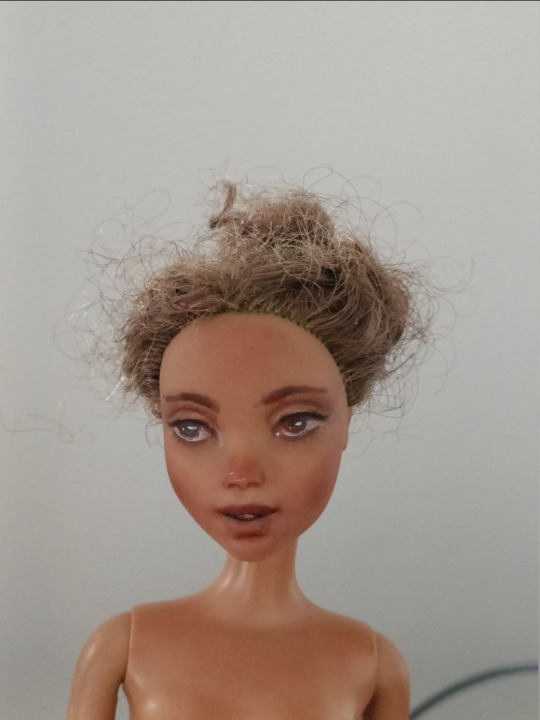
Undergarments
Combinations and stockings
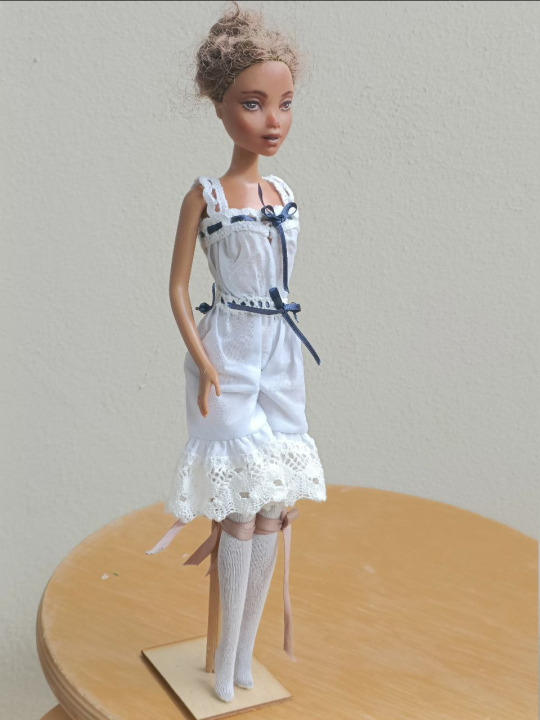
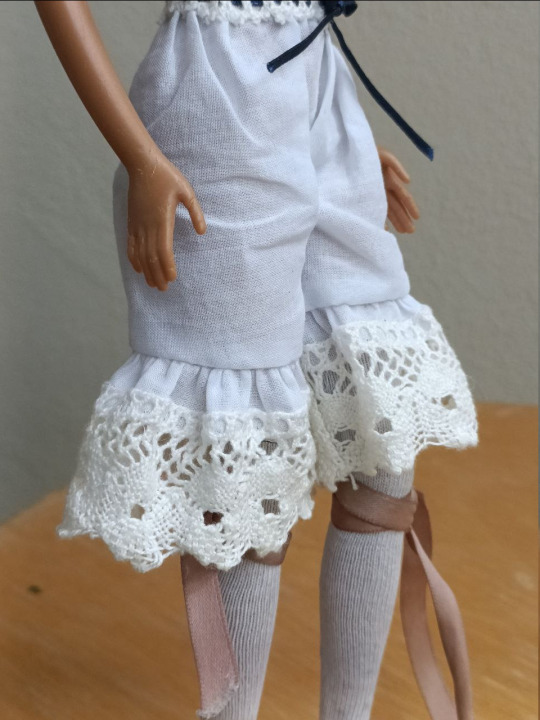
The combinations are split crotch as they were in the period. They are from thin cotton voile I have a lot of and is very appropriate. I didn't have really tiny enough lace for this, so it's kinda bulky, but I think it's okay enough. The stockings are cotton knit, which fits well. The garters are not actually necessary for this doll since her legs are rubbery.
Corset
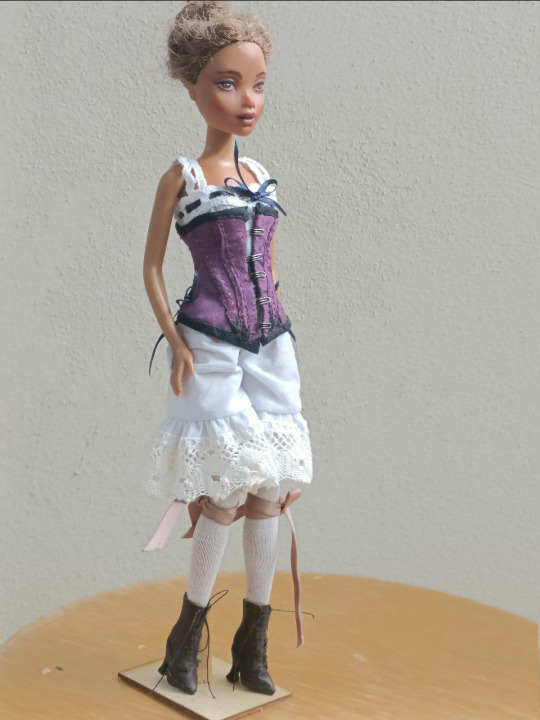
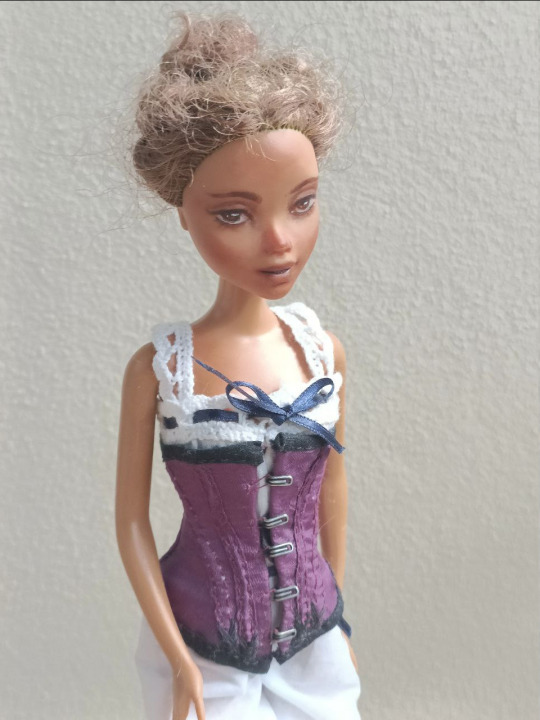
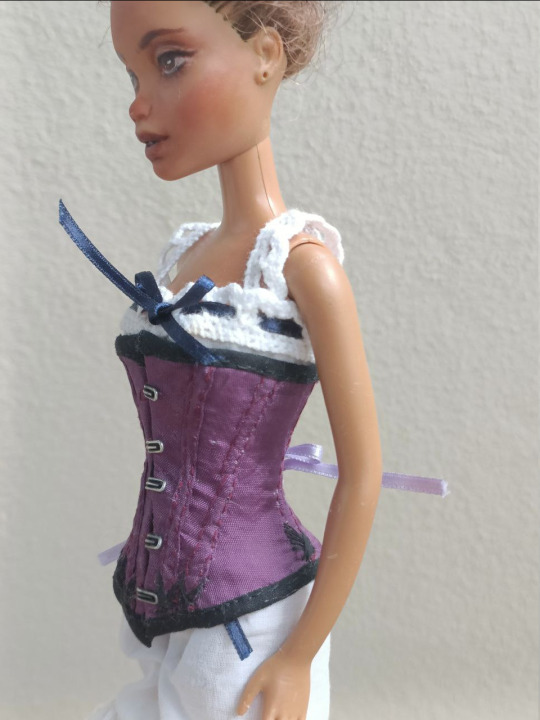
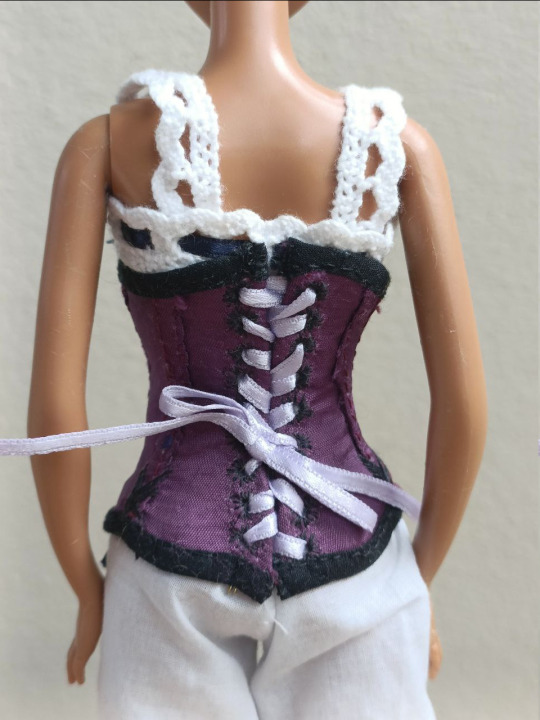
I made the corset from a firm-ish linen and satin rayon pretending to be silk as the fashion fabric. The stitching of the boning channels is not super neat, this fabric is very unforgiving, I didn't have exactly matching thread and the scale made it very difficult. I of course didn't have tiny busk, so I used small hooks, sewed thread loops for them and used narrow metal wire for the edges. I think it looks surprisingly right on the outside. I used the same wire as the boning to reinforce the lacing on the back. I didn't actually use boning elsewhere but the tightly packed linen edges in the boning channels kinda work like lighter boning. I think it keeps the shape pretty ways even with just that. I stitched cotton tape inside to shape the corset further. I also didn't have tiny metal eyelets so I hand-sewed the lacing holes.
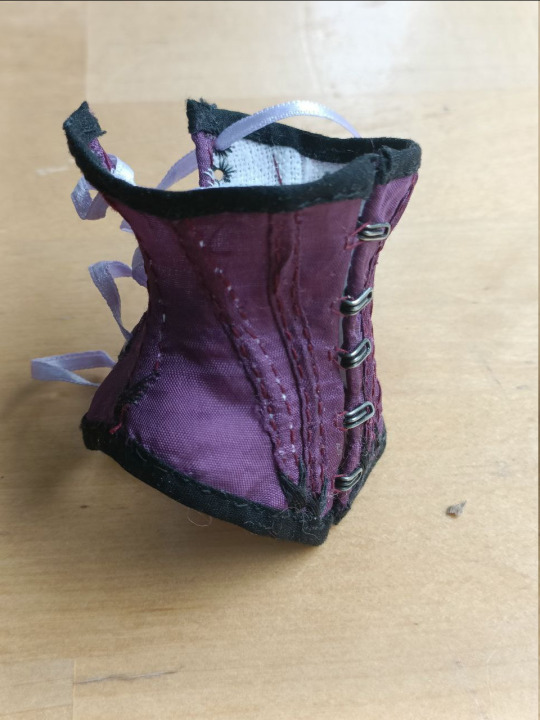
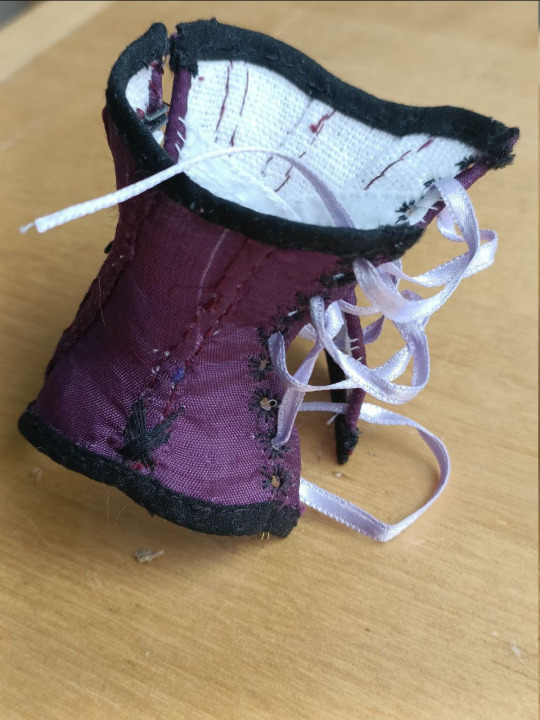
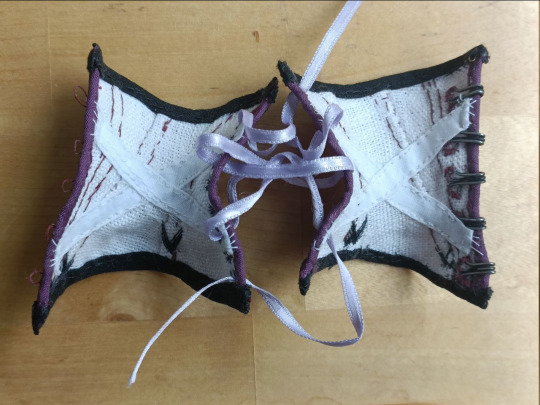
Bustle pad
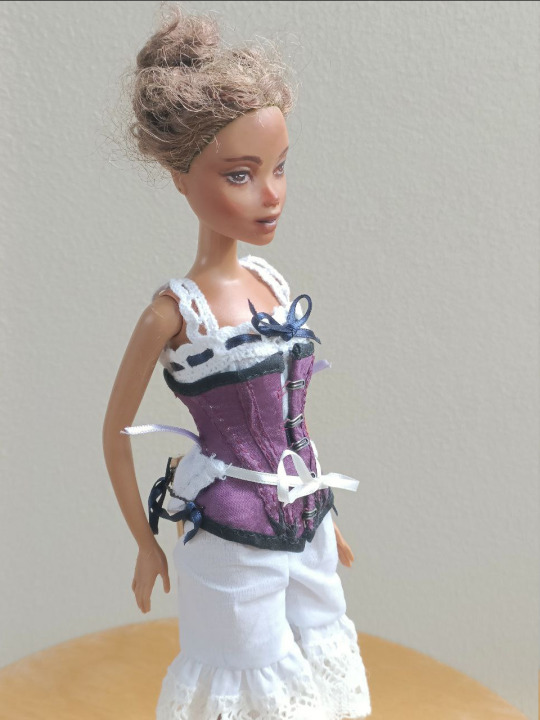
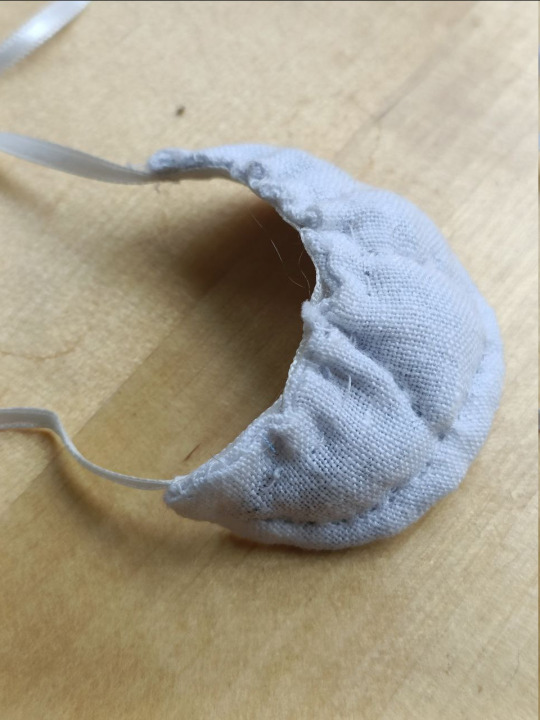
The bustle pad is from linen and stuffed with tiny cabbage.
Petticoat
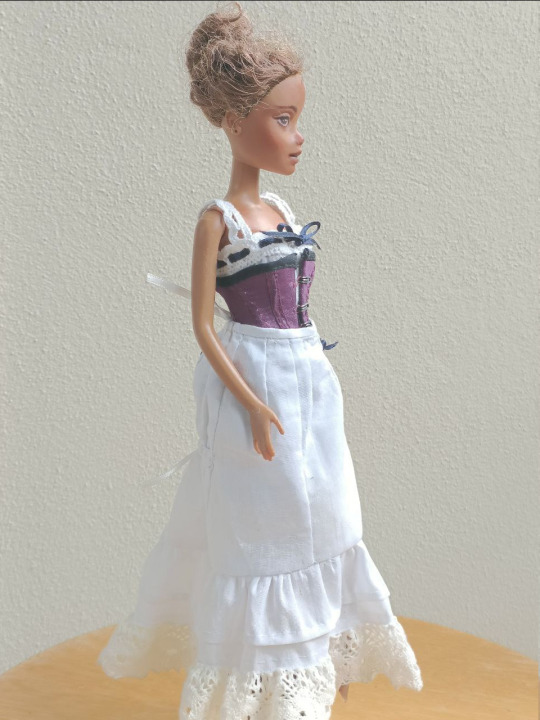
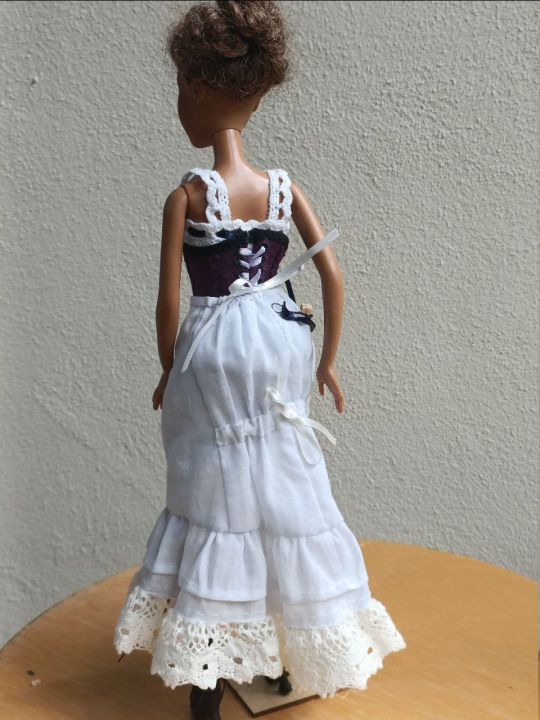
The petticoat is from the same cotton as the combinations.
Outer wear
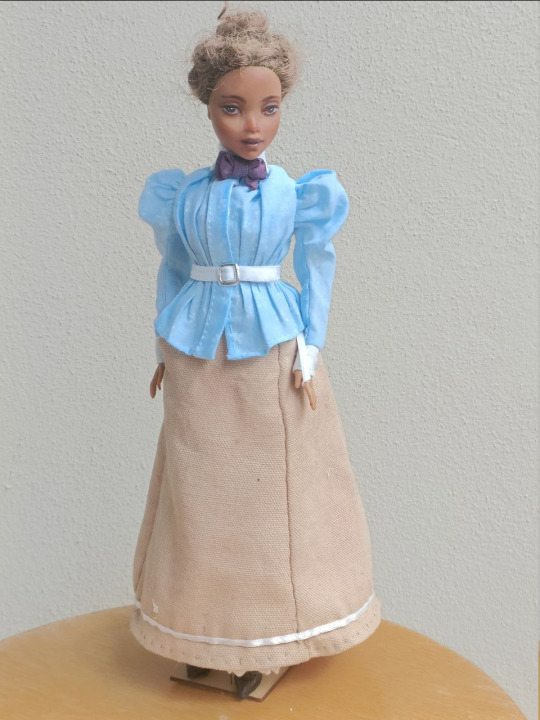
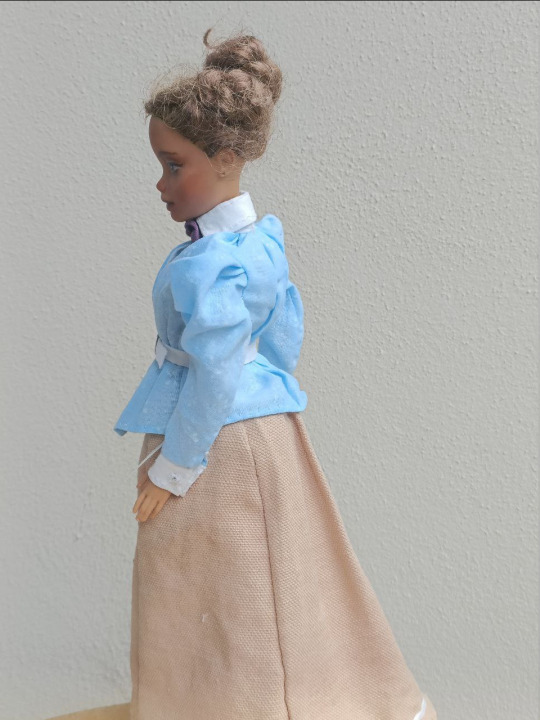
Skirt
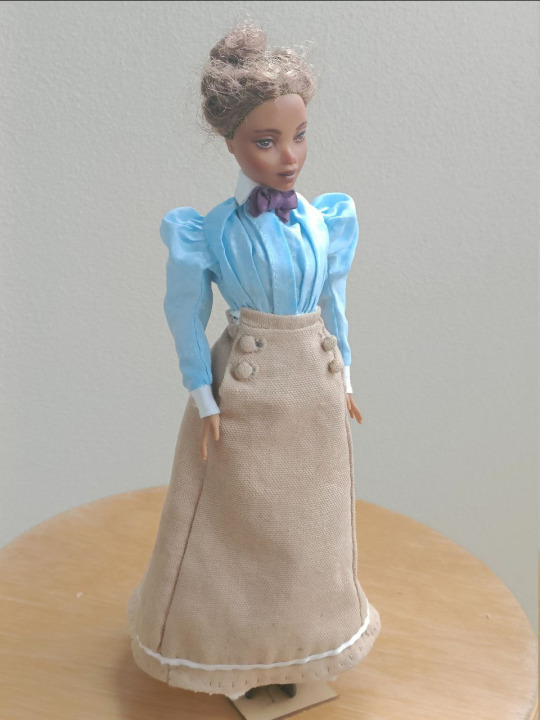
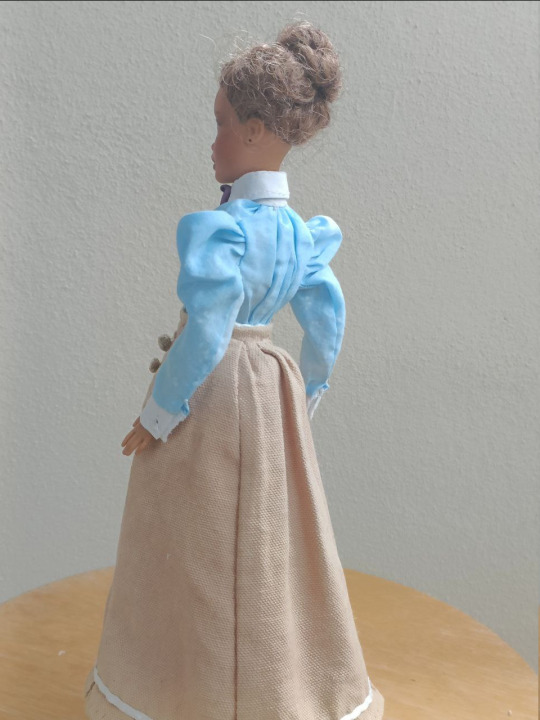
The fabric is cotton half-panama. It's pretty thin, but firm. I would have liked to use a woven wool, but I didn't have any that's thin enough to work in this scale. I think this cotton looks close enough in this scale to a wool with a tight weave, so I'm imagining it's that. My problem was that the cotton was white, but I wanted light brown. I wasn't going to buy any fabric for this, so I did the reasonable thing and dyed it with red onion peals (I've been doing natural dye experiments so this worked well for me).
Shirtwaist
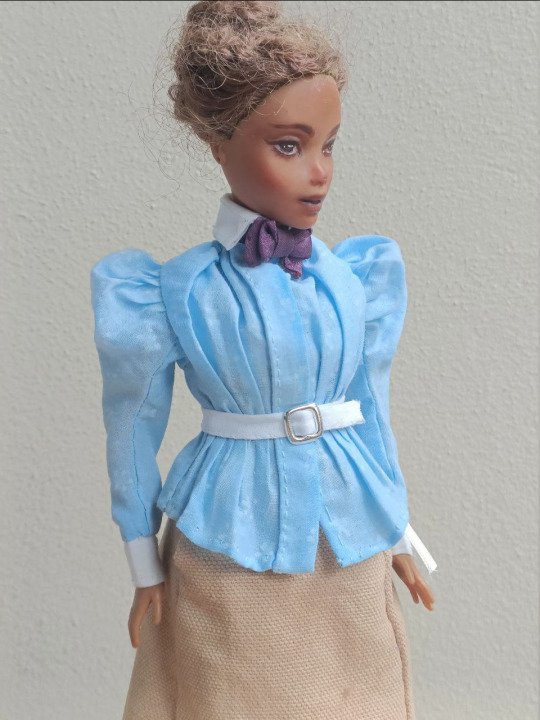
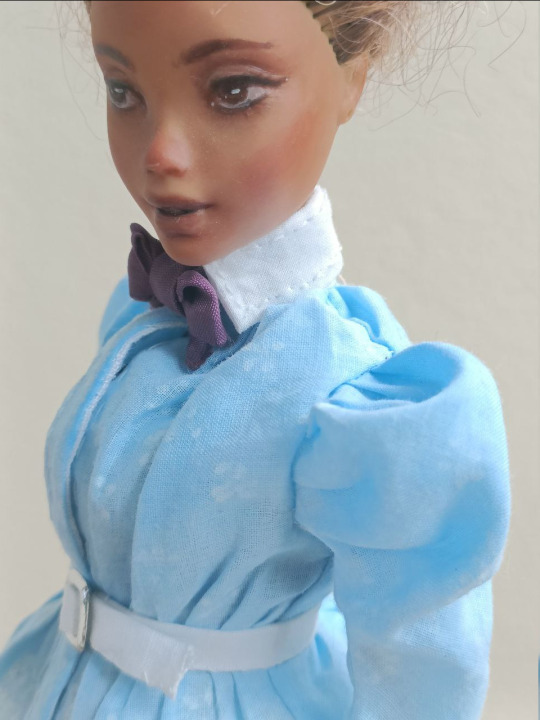
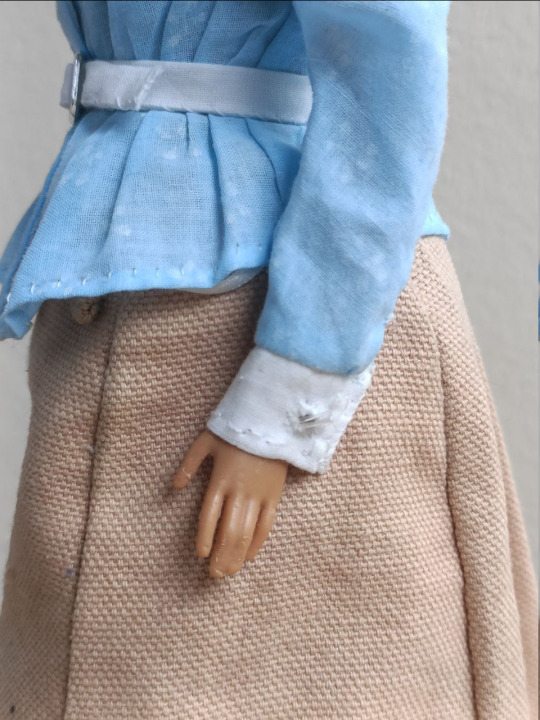
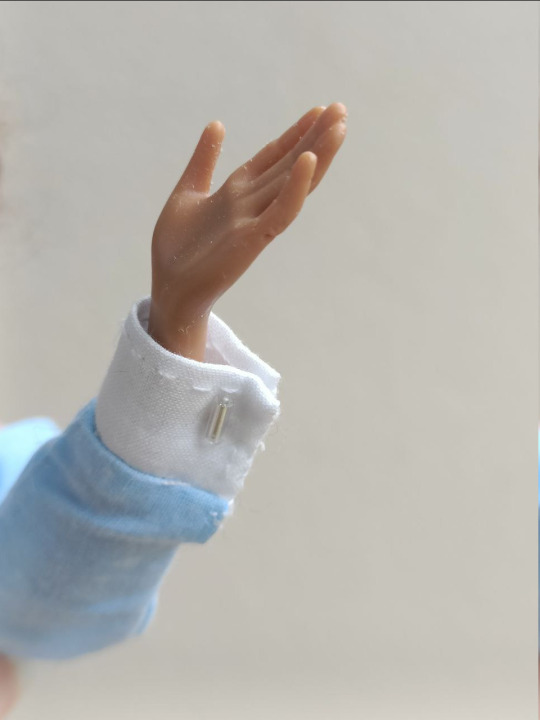
The shirtwaist is from the same cotton as the undergarments. Yes, I dyed it too. I didn't have thin enough cotton in a color that would fit with the skirt and the purple bow, so I dyed it light blue with fabric color. Since I already went the trouble of dyeing I decided I might as well make a small flower print to it since that was popular in the era. I didn't want it to jump out too much but the lighting makes it even less visible. I made it with a white fabric pen. The collar and cuffs are reinforced with linen. I also sewed small stick-like beads to the cuffs on both sides, so one acts as a button (I sewed a buttonhole too) and the other makes it look like they are cufflinks. The bow is from the same fabric as the corset and the belt is sewn from the same cotton as the shirtwaist. The buckle is from a barbie belt.
Waistcoat
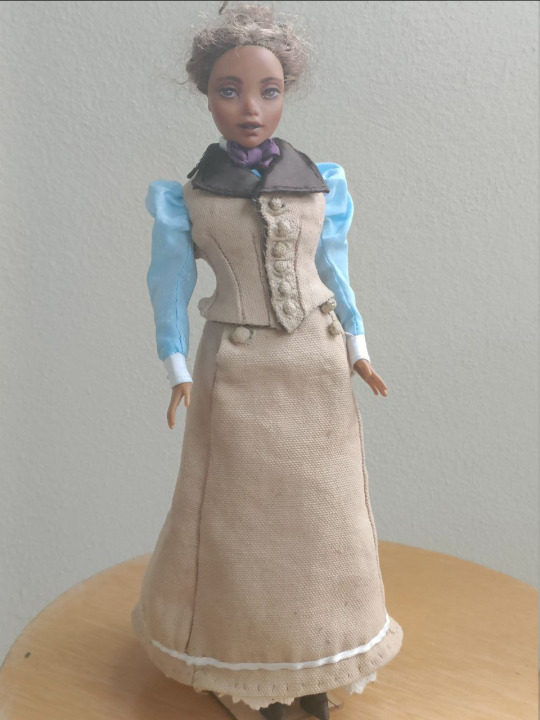
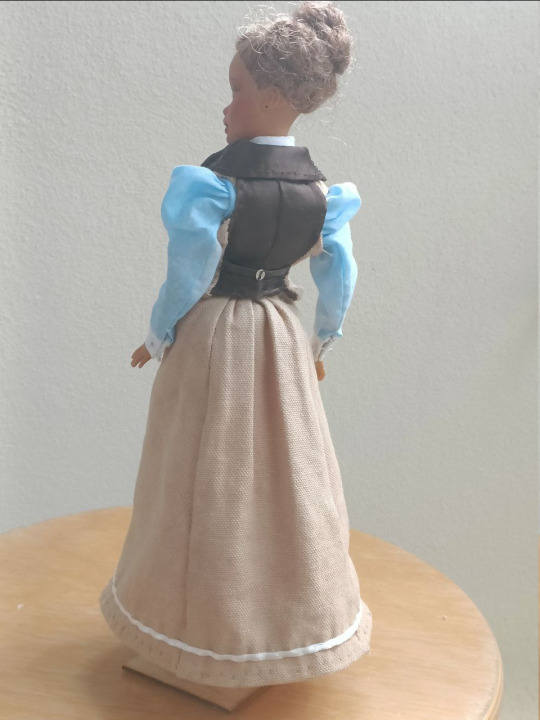
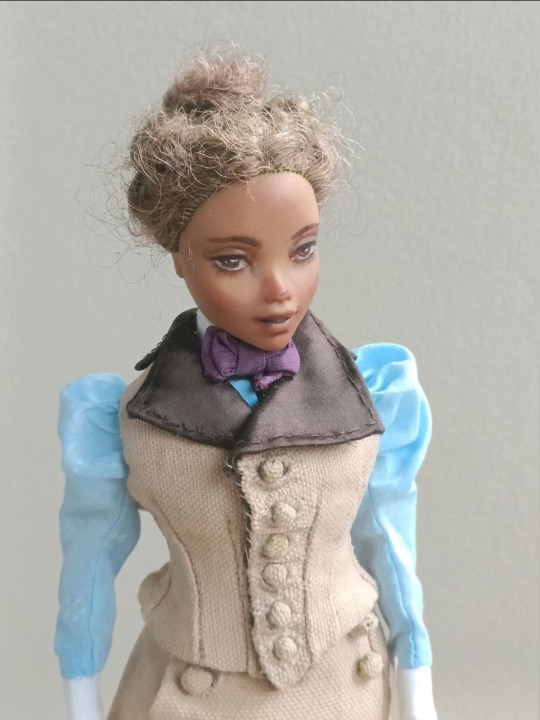
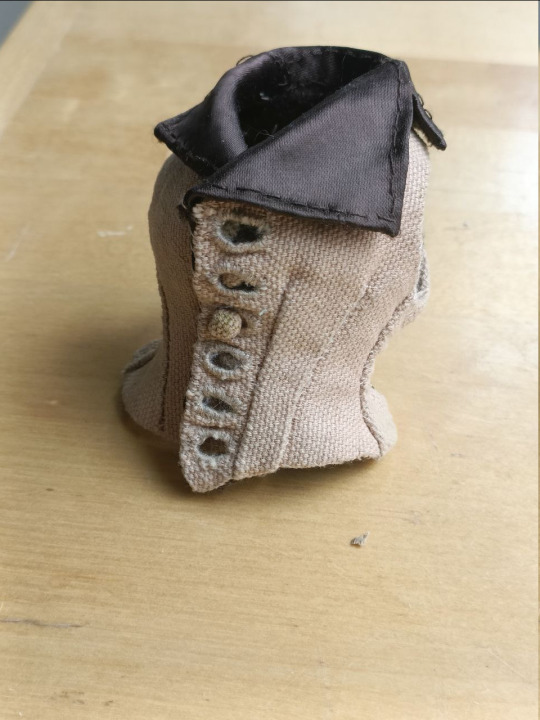
The waistcoat is from the same fabric as the skirt, thought the lapels and the back are from another satin rayon. I tailored the front panels and the lapels by stitching the linen interlining with tailor's stitches (I don't remember if that's the correct word in English) into shape. There is some wonkiness on one side of the hemline for some reason.
Boots
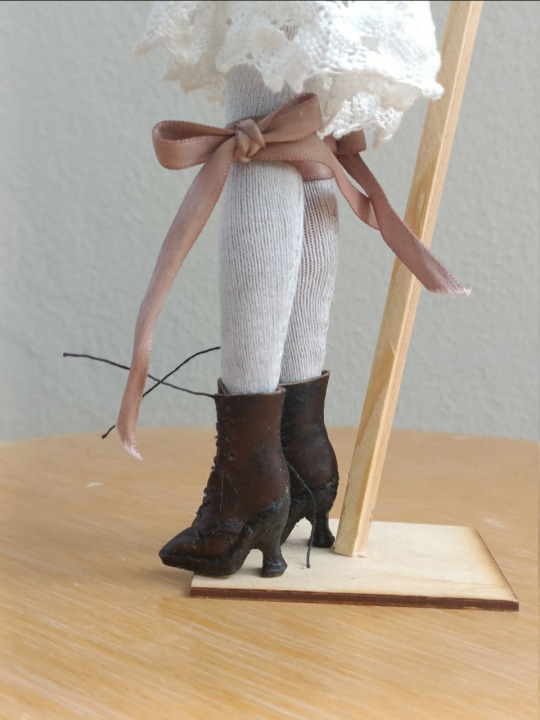
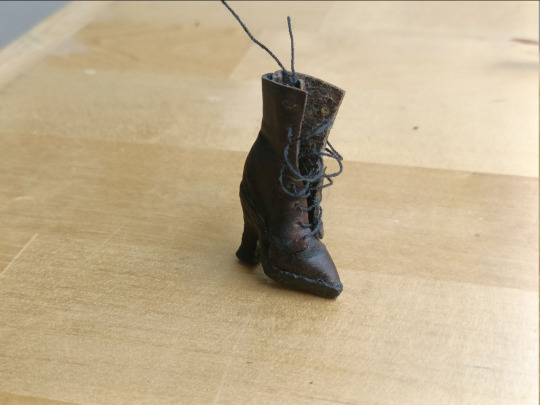
I made the slightly insane decision to make the shoes fully from leather, like they would have been in the period. I had an old broken leather wallet I had saved in case I needed some leather scarps. It has fairly thin leather, so it was workable here. It's light brown though, so I used black shoe polish to darken it. I wanted black or very dark brown shoes. I stacked the heels from glue and leather pieces and carved them into the right shape and sewed the shoe itself to leather shaped as the sole and glued it to the heeled and shaped sole. After I had shaped the shoes and the heels as much as I could I painted the heels black.
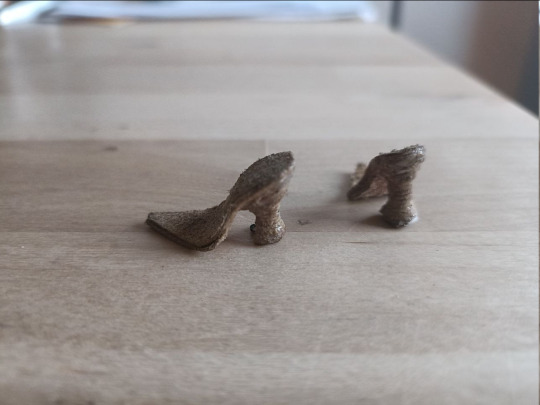
#historical fashion#fashion history#sewing#custom doll#ooak doll#victorian fashion#dress history#costuming#historical costuming#doll clothes#doll customization#historical sewing#my scene#my art#dolls
932 notes
·
View notes
Note
(Removing) corset kink? 🤪 with Diluc 😘🥰🥰
my beautiful wife who hits me where it hurts

Diluc is always achingly slow undressing you.
It hasn't always been this way - the first few times, when the two of you were still nervous about this new arrangement, his hands had fumbled with your buttons and your clasps - and in his nervousness, he had singed your corset ribbons, coming dangerously close to the soft, unmarked skin of your back. He had apologised profusely in that low, intense voice, his palms still searing hot as they'd slid down the curve of your spine--
But he'd made sure, the next time, that he'd taken his time, if only to try and ensure that he didn't leave you with scorch marks on your pretty things and burns upon your flesh.
It is not an entirely unwelcome change, but the sensation of your gown being slipped past one shoulder and then another, of every inch of skin being exposed so slowly that time ticks by like treacle . . . well, it's enough to make the heat in your stomach coalesce into a ball of need so intense that you can barely stand it.
Warm lips caressing the nape of your neck, sliding down, down, over your shoulderblades. His fingers, following the line of your corset with a soft sigh.
"You always dress so nicely for me," he whispers, his voice rough with the grit of desire as it curls like smoke into your ear. "It's a shame to take it off."
"You're just afraid you'll be too clumsy," you whisper back to him teasingly, and Diluc makes a soft harrumph against your skin that sets your nerves buzzing with anticipation.
"Just for that," he murmurs, and you feel his fingers tug at the ribbons that hold your corset laced, "I'm going to take my time with this."
He's true to his word.
For every millimetre of your corset that he sees fit to unlace, he spends ten seconds kissing at your bare skin, sucking at your shoulders until you're sure lovebites will bloom all over you, letting his warm breath fan over skin that he already knows is aflame with your want for him. You squirm in front of him - at one point you even reach up, to try and undo the catches at the busk of the corset yourself, only to find your wrists pinned by his hand.
"If you're going to be like that," Diluc murmurs, with an undercurrent of steel that reminds you of how feared he is amongst certain subsets of villains, "then I'll simply have to tie your wrists up with your ribbons, won't I?"
The threat shimmers in the air, as you swallow back your protestation with an indecently loud noise that makes Diluc groan in the back of his own throat - but you're well-behaved, as you take the kisses and the touches and the softness, even as you blaze with need. You can feel your nipples, tight and wanting, pressing against the chemise you wear beneath the corset. You can feel your own slickness as it practically drips down your thighs, soaking the little scrap of silk that is masquerading as underwear. And most of all, you can feel him, his own want just as hazy as yours.
When Diluc finishes - when the corset is finally peeled away, when you can turn and throw yourself at him and kiss him as hungry and needy and fiercely as you wanted to the whole time, the heat in the room still feels hot enough to burn through satin.
182 notes
·
View notes
Text
Word List: Fashion History
to try to include in your poem/story (pt. 1/3)
Adinkra - a flat, cotton textile that is stamped with symbols which create the meaning of the garment; produced by the Asante peoples in Ghana
Agal - a rope made from animal hair which wraps around a keffiya (square cloth) on the head and is worn typically by Bedouin men
Akwete - a decorative cloth with complex weave designs, creating intricate geometric patterns, made with many vibrant colors; it is usually made into wrappers for women to wear and it is made by the Igbo women of Nigeria
Aniline Dyes - synthetic, chemical dyes for garments first invented in the 19th century
Anorak - a jacket that typically has a hood, but not always, which was originally worn by the indigenous peoples of the Arctic designed to keep them warm and protected from harsh weather
Back Apron (Negbe) - an oval-shaped decorative pad worn by Mangbetu women over the buttocks in Central Africa
Backstrap Loom - a lightweight, mobile loom made of wood and a strap that is wrapped around the back; it only needed to be attached to a tree or a post for stability and to provide tension
Banyan - a loose-fitted informal robe or gown typically worn by men in the late 17th to the early 19th centuries
Barbette - a piece of linen which passes under the chin and is pinned at the sides, usually worn in conjunction with additional head coverings during the Middle Ages
Bark Cloth - fabric made out of bark from trees
Beadnet Dress - a decorative sheath dress made of beads worn in ancient Egypt
Bloomers - a bifurcated garment that were worn under dresses in the 19th century; they soon became a symbol of women’s rights because early activist Amelia Bloomer wore drawers long enough to stick out from under her dress
Bogolanfini - (bogolan- meaning cloth; fini- meaning mud) a cotton cloth made from strips of woven fabric, which are decorated with symbolic patterns using the mud-resist technique, sewn together at the selvage to create a fabric that is utilized during the main four stages of a West African Bamana woman’s life: puberty, marriage, motherhood, and death
Bombast/Bombasted - the padding used to structure clothing and create fashionable silhouettes in the 16th and 17th centuries
Boubou - an African robe made of one large rectangle of fabric with an opening in the center for the neck; when worn it drapes down over the shoulders and billows at the sleeves
Buff Coat - a leather version of the doublet that was often, but not exclusively, worn by people in the military in the 17th century
Bum Roll - a roll of padding tied around the hip line to hold a woman’s skirt out from the body in the late 16th and early 17th centuries
Burqa - an outer garment worn by Muslim women that covers the entire body, often with a cutout or mesh at the eyes
Busk - a flat length stay piece that was inserted into the front of a corset to keep it stiff from the 16th century to the early 20th century
Bustle - a pad or frame worn under a skirt puffing it out behind
Cage Crinoline - a hooped cage worn under petticoats in the 19th century to stiffen and extend the skirt
Caraco - 18th century women’s jacket, fitted around the torso and flared out after the waist
Carrick Coat - an overcoat with three to five cape collars popular in the 19th century and mostly worn for riding and travel–sometimes called a Garrick or coachman’s coat
Chantilly Lace - a kind of bobbin lace popularized in 18th century France; it is identifiable by its fine ground, outlined pattern, and abundant detail, and was generally made from black silk thread
Chaperon - a turban-like headdress worn during the Middle Ages in Western Europe
Chemisette - a piece of fabric worn under bodices in the 19th century to fill in low necklines for modesty and decoration
Chiton - an ancient Greek garment created from a single piece of cloth wrapped around the body and held together by pins at the shoulders
Chlamys - a rectangular cloak fastened at the neck or shoulder that wraps around the body like a cape
Chopines - high platform shoes worn mostly in Venice in the 16th & 17th centuries
Clavus/Clavi - decorative vertical stripes that ran over the shoulder on the front and back of a Late Roman or Byzantine tunic
Clocks/Clocking - decorative and strengthening embroidery on stockings in Europe and America during the 16th-19th centuries
Cochineal Dyes - come from the Cochineal beetle that is native to the Americas and is most commonly found on prickly pear cacti; when dried and crushed, it creates its famous red pigment that is used to dye textiles
Codpiece - originally created as the join between the two hoses at the groin, the codpiece eventually became an ornate piece of male dress in the 16th century
Cuirass Bodice - a form-fitting, long-waisted, boned bodice worn in the 1870s and 1880s–almost gives the appearance of armor as the name suggests
Dagging - an extremely popular decorative edging technique created by cutting that reached its height during the Middle Ages and Renaissance
Dalmatic Tunic - a t-shaped tunic with very wide sleeves; worn by both men and women during the Byzantine empire
Dashiki - a loose-fitting pullover tunic traditionally worn in West African cultures that was adopted by African diasporic communities as a symbol of African heritage in the 1960s and then more widely worn as a popular item of “ethnic” fashion
Dentalium Cape - or dentalium dress is a garment worn by Native American women that is made from the stringing together of dentalium shells in a circular pattern around the neck and across the chest and shoulders
Doublet - an often snug-fitting jacket that is shaped and fitted to a man’s body–worn mostly in the 15th to 17th centuries
Échelle - a decorative ladder of bows descending down the stomacher of a dress; worn during the late 17th and 18th centuries; sometimes spelled eschelle
If any of these words make their way into your next poem/story, please tag me, or leave a link in the replies. I would love to read them!
More: Fashion History ⚜ Word Lists
#word list#fashion history#writeblr#dark academia#spilled ink#writers on tumblr#writing prompt#terminology#poetry#poets on tumblr#literature#light academia#studyblr#linguistics#lit#words#fashion#culture#worldbuilding#creative writing#writing reference#fiction#writing tips#writing advice#writing resources
299 notes
·
View notes
Text
𝚃𝚑𝚛𝚘𝚞𝚐𝚑 𝚝𝚑𝚎 𝚂𝚖𝚘𝚔𝚎 𝚊𝚗𝚍 𝙵𝚘𝚐

Here is my submission for @kentopedia's wonderful Love Through the Ages collab!
➻ Summary: Trapped in the gilded cage of Victorian high society, you were determined to rebel. You ran the streets in disguise at night and threw yourself into your work as a typist for Scotland Yard during the day, rejecting the label of “quiet, submissive woman.” Further rebuffing the ideals of your time, you scoffed at the idea of love and marriage, but a certain blonde Detective Inspector always seemed to make your heart flutter. You’re assigned to work a case under him, and your feelings only grow more complicated… but will your budding romance be able to survive one of history’s most infamous murderers?
➻ Pairing: Nanami Kento x afab!Reader
➻ Rating: Explicit (18+, minors DNI)
➻ Word Count: 8.2k
➻ Warnings: Explicit sexual content and Discussions of the Jack the Ripper case/thematic elements related to the case/time period (rape, poverty, etc.)
➻ Song recommendations (in order):
Toxic- From “Promising Young Woman” Soundtrack performed by Anthony Willis Les feuilles mortes- Jean-Michael Blais The Swan- Camille Saint-Saëns
➻ Author's note: I did a ton of research to make sure I had my details correct, so there are tons of easter eggs hidden in the fic. I had a lot of fun with this one!
Join my taglist here!


Colors flew through the air as you tossed various skirts, bodices, and any other accessories unfortunate enough to catch your ire clear across the room. They hit your quilted bedsheets with an audible thunk as Misato shook her head at your antics, tsking at you from the corner.
“Love, you’ll be late if you carry on like that. Wipe that scowl off and pick one already.”
You shot the maid another half-hearted frown, looking as grim as a young woman clad in only her chemise, garters, and stockings could. Misato strode over with matronly confidence, snatching the next garment out of your hands before it could grace the top of the pile. She held the bodice up, inspecting it in the clear morning light before giving a brisk nod.
“Right then, this will do. It’s posh enough to keep your father happy without all those extra frills and ruffles you hate. Grab that skirt, and let’s get on with it.”
You did as you were told, albeit extremely unenthusiastically. Misato hummed soothingly, draping the familiar weight of a corset around your waist. This was a dance you knew the steps of all too well. You fastened the busk up quickly before bending down to grasp at the foot of the bed, adjusting your decollete into the supporting garment. Misato tightened the laces systematically, just as she had done for every year you’d been old enough to dress as a woman.
Standing back up, you moved your body around, wincing and rolling your shoulders as you reacclimated to the squeeze of the steel boning.
“I’m sorry,” you murmured, dropping your head in apology at the sight of her soft frown. “I know I’m bull-headed, and I know it only causes trouble for you.”
With a gentle sigh, the maid slipped a muslin camisole over your head before moving to fasten a bustle around your waist. “I understand, love. But you’re a woman of society, and you’re to dress as such. Now, bear you in mind, I’d rather die than see you in trousers like the men, but I think there’s a middle ground to be found yet.”
You smiled at her, grateful for the affection, “I know, but I’m still glad to hear it.”
“Who knows… Maybe you’ll finally attract a husband who’ll let you run as wild as you’d like.” The older woman teased you, pinching your cheek affectionately as she slipped several layers of skirt over your head. Her loving prodding pulled an imperceptible flush across your cheeks, and you distracted yourself with the buttons of your bodice. “Lord knows some of those peelers can’t be too horrible to look at.”
“Love,” you scoffed, choosing to ignore the way your mind immediately wandered to a certain stoic, blonde detective, “is for little girls who still believe in fairy tales.”
You continued on, selecting a hat from a drawer. “I work because I want to do something important… something beyond embroidery and gossiping at garden parties. There are people out there who need help, Misato.”
The maid laughed softly, pinning your hat at a perfect, jaunty angle. “I’ve known that since you stood at the height of my knee, but I can still hope to see you happy.”
You bade Misato goodbye with a quick kiss on the cheek, finally venturing out from your family’s warm, comfortable house to wait by the road for your carriage. An icy breeze brushed past as soon as you stepped outside, ruffling through your skirts and causing you to shiver. As you waited patiently, the damp air slowly seeped under your multiple layers of clothing; the strangely oppressive chill only took a few moments to carve beneath your skin like an icy dagger.
Normally, little birds would flitter throughout the small yards alongside the street, filling your morning commute with their cheerful racket, but there was only silence today. Your only companions were the ever-present fog and smoke that blanketed the city, but today, they seemed so much thicker than usual, making the overcast sky feel even more bleak.
Thick tendrils of gloom trailed over the cobblestones, swallowing the flickering gas lights one by one. There were no people on your street this early, no signs of life to be seen anywhere. Another shiver shot down your spine, but this time, it had nothing to do with the cold. The world was grey and eerily silent as the fog finally reached you, blanketing your entire body with frigid mist. The downy hairs on the back of your neck began to stand on end; everything felt off… like an ill omen.
A moment later, the clacking of hooves on the cobblestone echoed throughout the street, and a familiar carriage finally appeared in the gloom. You barely waited for it to come to a stop before you opened the door and climbed in, not caring to observe the proper etiquette.
“Cold, miss? It’s a chilly mornin’ innit?” The driver chuckled, shouting loudly as he snapped the reins, urging the horses to return to their steady gait. “Don’t worry; we’ll get you back inside soon enough.”
“Ah, yes… It is a bit chilly.” You smiled and brushed your actions off with a laugh, but the feeling of dread still weighed heavily on your heart.
Even the horses seemed restless, rolling their eyes and tossing their well-groomed manes back and forth as they plodded eastward. You were grateful to finally see some sense of normalcy as you reached Victoria Street, where people of all ages milled around, setting up their businesses both on and off the street. Shops opened their doors, and street vendors set out their wares, squabbling loudly over placement and price. You smiled wryly as a young boy snatched a steaming pie from the corner of a table, eyes shining with delight as he shoved the greasy pastry into his mouth. He disappeared into the teeming crowd with the shopkeep still blissfully unaware of the theft.
The sight was as endearing as it was heart-wrenching; the cute little boy probably stole out of sheer necessity. If he hadn’t stolen the pie, there was a good chance he wouldn’t have eaten at all today, even in this area of the city. You suddenly felt guilty that you had the privilege of being able to turn down breakfast.
“So much needs to change,” you murmured, drumming your gloved fingers against the lacquered side of the carriage. Most of the people from the upper crust simply wanted to hide the poor away; their attitude was just to keep them out of sight and out of mind.
Your thoughts continued as you looked off into the alleyways and then glanced eastward to where the worst parts of London were concealed. If your family had their way, you’d have never known those parts of the city existed; you’d have been kept on a pedestal in the opulent West End. To them, all you needed was decorative knowledge meant to accent your pretty face and attract a rich husband, but no one had counted on your tenacity. You had been too intelligent, too fierce of a little girl, always demanding answers from your tutors, rejecting their half-baked excuses about the world and how it worked.
Before long, you figured out that not all people grew up similarly. You fished stories out of maids and butlers, learning about how other people suffered in the cruel workhouses and filthy alleyways hidden in the background of the city you loved. But the most appalling thing by far was how little your parents and their wealthy friends seemed to care.
When you turned ten, you convinced Misato to help you sneak out for the first time, mainly by threatening to go even if she refused to be your accomplice, and from that night on, you began exploring the real London. When your parents thought you were safely locked away in your room practicing embroidery, you were actually exploring the streets wearing ragged clothes “borrowed” from the nearest bin. It was dangerous and wholly irresponsible for a lady like yourself, and if anyone found out, your reputation and life would be ruined forever…. So, of course, you loved it.
“It’s no wonder I ended up here, in the last place a ‘lady’ should ever be.” You murmured, smiling as the carriage finally jolted to a stop outside the stately, brick-and-stone building at 4 Whitehall Place. The driver opened your door with practiced ease, and you entered Scotland Yard’s world of cops and criminals.
“Odd, there’s so few people here…” You murmured, arching an eyebrow in curiosity as you walked in and reached your desk.
Typically, the station was filled with men waiting on their orders for the day or waiting to go on patrol. The few men who were present milled about restlessly, and most wore the trademark blue peeler uniform. However, two men were notably different; they were dressed in everyday clothes and stood off to the side of the Chief Inspector’s office. If you didn’t know better, you could’ve guessed they were gentlemen who simply wandered in off the streets.
“I haven’t seen those two before. They must be detectives.” You pieced together, noting the tension that hung heavily around them.
The two men were certainly young to be detectives, but one seemed more experienced and slightly calmer than his counterpart. They each wore black frock coats and trousers, but from there, the appearance differed. The composed man had kind eyes and tawny, disheveled hair covered with a bowler hat, whereas his friend sported a red vest, fluffy hair, and no hat. He looked younger and full of nervous energy; for some reason, his hair seemed oddly…. pink?
You sighed, chalking it up to a trick of the light as you set up your desk for the day. In a valiant attempt to neutralize your own nervous energy, you began to clean your typewriter, stealing glances at the young detectives, trying to parse together what was going on from snippets of their conversation.
“Do you really think- how long will it take?”
“I don’t know, just wait and see.”
Suddenly, two more men you did recognize walked into the room without fanfare. Chief Inspector Yaga led a tall, serious-looking blonde man over to the others, and your heart fell through your chest at the expression on his face. Not many of the detectives treated you well, but in all the time you’d worked there, Detective Inspector Nanami Kento had never failed to greet you with a small smile and a polite greeting every morning at the bare minimum.
This morning, however, his expression could have cut through stone. The stoic man’s lips were set into a cold, hard line, and he didn’t even notice your presence. His dark eyes glittered in intense concentration, and the two young men snapped to attention as soon as he approached them.
Something has happened. Those aren’t the eyes of the gentleman I know… that’s the gaze of a detective entirely focused on his case.
Scotland Yard and its detectives were no strangers to tragedy and brutal events. They carried the weight of investigating the most unspeakable acts people could inflict on each other, but you had never seen DI Nanami look quite this grim. You watched the four men talk quietly for what seemed like ages before they finally walked over to your desk. Chief Inspector Yaga looked you up and down with a critical gaze as if to size you up.
“How can I help you this morning, sir?” You met his eyes calmly, the feeling of dread rising, squeezing your heart once again.
“You’ve been with us for almost two years now, correct?” His gruff voice rumbled through you like thunder promising an oncoming storm.
“That’s correct, sir.”
“And you’ve never had any-” He paused, gesturing around as if searching for the correct word, “trouble with the cases up until now?”
Nanami’s chiseled jaw clenched as the Chief Inspector questioned you. He seemed to be looking just past your face, staring at a spot on the wall in a manner that seemed as though he was willing it to spontaneously catch fire. You didn’t try to hide the way your brow furrowed in concern at the question.
“Trouble, sir?”
He sighed, rubbing the bridge of his nose. Deep, dark bruises were blooming under the man’s eyes; it looked as if he had gotten little-to-no sleep for weeks. “I know you’ve certainly heard… more than a few disturbing things in your time here. The paperwork you tend to has details of crimes, and you’re around the men every day…. God knows they don’t know when to hold their tongues.”
You nodded along, still confused and growing exponentially more concerned. His words were true; you’d certainly heard more than your share of gory details from the policemen as they returned from their patrols, whether it was just accidentally overheard or they told you directly as if it would impress you.
“Well… It is never enjoyable, but I deal with it in the same way the men do, sir.” You pointed out deftly, unwilling to seem fragile.
Nanami remained grimly silent, but a small smile played across the corner of his lips as Yaga watched you closely. After a moment of silence, the burly DCI sighed again. “Then there’s a job for you. I am about to ask more of you than I would like to, but you’ve excelled at your current position, and this situation calls for related skills.”
For the briefest moment, you could’ve sworn that you saw Nanami’s fist clench at his side. Still, the stoic man stayed silent as Yaga continued on, “You’ll be working under DI Nanami, and your main responsibility will be to organize and keep a running record of the evidence as it comes in. You’re to help them keep track of any papers they need to revisit during their investigation. Other duties will be assigned as needed.”
Yaga nodded stiffly and walked back to his office, shutting the door firmly as if to signal the finality of his decision. You looked up at Nanami with concern, as the man had barely moved since he arrived at your desk; he still looked silently furious. “Are you… do I need to do anything right now?”
His mood seemed to shift to calm in an instant. “No, nothing right now. I’ll have a file to give you as soon as I return, but I do need to introduce the case to you so that you’re not blindsided when you… see it.”
Nanami motioned for the two young detectives to step forward, “First, this is DC Itadori, and this is DS Ino. They will also be working under me for this case; if you have any issues and I’m unavailable, you can go to them.”
The two young men tilted their heads in polite acknowledgment as they were introduced, each giving you a small smile, almost like the one Nanami usually reserved for you.
Ino spoke first, “It’s a pleasure to meet you, Miss. Even under these circumstances.”
Itadori nodded enthusiastically, “Yes! It isn’t often we get to work with a-”
“And I think it’s time for us to go secure transportation to the scene. You’ll have to excuse us.” Ino butted in quickly, placing a firm hand on Itadori’s shoulder and hauling the young man away, blatantly ignoring his noises of protest.
You turned back to the Detective Inspector, whose expression was unreadable as he sighed, “He means well. Please forgive him.”
A small, reassuring smile touched your lips as you gazed up at Nanami, “I’m not offended, Detective. I’m no shrinking violet and a bit of levity won’t go amiss every now and then.”
Your small quip made the blonde man chuckle lowly despite the situation. “I’m well aware. But this case….” His expression shifted once again. “I don’t like involving you in it.”
Hurt shot through you, stabbing through your heart with a dull ache. You had worked alongside him for two years, and he’d never seemed like the other men who constantly doubted your abilities for the supposed sin of being born a woman. You liked this man; you had trusted him.
“Do you really not think I can be of help?” You frowned as indignation seared through your veins.
You must’ve looked truly hurt because Nanami shook his head. “It has nothing to do with ability. You should know that I hold your abilities in high regard, but…” he said softly, “this case- it’s nothing like you’ve ever seen before, and you should never have to see things like this. No one should.”
Your firey attitude froze instantly, turning to shame as you realized his true intent. “Forgive me, I’m used to….”
A flush crept across your cheeks as you took a deep breath, smoothing the fabric of your skirt and regaining your professionalism.
Why is it so easy for me to make a fool out of myself in front of you?
“ I understand,” he murmured, studying the typewriter in front of you with a strange intensity. “You may as well come into my office and have some tea.”
–
It took you no time at all to understand exactly why everyone seemed on edge and why the Detective Inspector was so affected by the case. You had read files of violence, murder, and rape before, but what Nanami had to sit down and tell you was beyond all of that. There was a monster, some sick freak brutalizing and murdering women throughout the streets of Whitechapel. He toyed with and desecrated their bodies, and all evidence suggested that he had acted multiple times and was going to continue unless he was caught or killed. This wasn’t some random act of criminal violence or murder of passion committed by a jilted lover…. this was something only the devil himself could be capable of.
The warmth of the teacup against your hands brought you some comfort, but you couldn’t bring yourself to drink any of the tea. Your stomach roiled violently; you were suddenly immensely glad you’d skipped breakfast as Nanami softly explained what had happened to the women and the events that led to Yaga deciding that you’d join his team.
“They found another body this morning,” he spoke plainly, but his deep brown eyes roamed over your face, his expression full of gentle concern. “Worse than the last, even.”
You glanced at the thick file in front of you, your stomach lurching as your eyes landed on the sketch of the previous victim. If it was only growing worse… God, you couldn’t even imagine…. The room suddenly felt too hot, your corset too constricting as you leaned forward, fighting the bile that rose in your throat.
Nanami was by your side instantly, his large hand warm and soothing on your back as he knelt beside you with surprising grace. “If you don’t want to do this…. I understand. I swear I do. Just say the word, and I’ll have you home.”
It took a brief moment, but you swallowed thickly and straightened up, your eyes glittering in determination as you gazed down at the kneeling man. “No. I can’t- I won’t- sit idly by, knowing I had a chance to help, even if it’s just in a small way.”
An entire moment passed as the two of you stared into each other’s eyes. Nanami rested his hand on yours for a brief moment, giving it a gentle squeeze, and you could feel your brain short-circuit. You were much closer to a bachelor than society would deem appropriate, but the desire to uphold proper values wilted against your need for comfort.
The moment was over quickly, and the Detective stood, brushing dirt off his tan pants. “It’s time for me to head out to the crime scene. I’d like you to use my office while I’m gone.”
Nanami gave you an achingly soft smile, the exact smile you had craved before he tugged his coat on, slid his unique, round glasses into place, and left the room.
–
Weeks turned into months, but the monster who called himself Jack the Ripper still hunted the women of Whitechapel. It didn’t take long for the press to run with the story, drawing more attention to Jack than his victims. An endless flow of letters and tips began to pour in every day, and the monster had even penned a few himself, mocking the police for not being able to catch him yet.
You spent every day working beside Nanami, who insisted you move into his office, claiming you could work more comfortably there. The attraction you felt towards the stoic detective grew as you spent more time with him, sharing the intimate workspace. He was always so busy and stressed beyond measure, but he was unfailingly kind and considerate of you. In return, you went above and beyond your assigned duties to care for him. You ensured that Nanami ate as regularly as possible, brewed him tea when he was having a particularly hard day, and provided him companionship.
You had always known that Nanami was intensely intelligent and focused, but he truly gave all of himself to this case. Unfortunately, the Ripper seemed to be a shade able to pass through walls for all the helpful clues he left behind. You watched, feeling utterly helpless, as the pile of bodies grew and the dark circles under Nanami’s eyes deepened. Despite putting on a brave face, he seemed frustrated and permanently exhausted; if you had to guess, he even slept at his desk some nights.
As the case progressed and even more women were killed, Nanami made it a point to make sure you were safe, even though you lived on the opposite end of London from where the murders occurred. You reassured him that you’d be fine, but he still gifted you a small firearm, a Derringer, that you kept tucked in your handbag every single day as both a good luck charm and a deterrent. The detective also insisted on escorting you home at night, and on the rare nights he was unavailable, he sent Ino or Itadori in his stead.
However, most nights, you only waited inside for an hour or two before sneaking back to the streets. You were convinced the people who frequented the bustling pubs and taverns of Whitechapel had to have more information. Many people weren’t keen on sharing any information with the police, but you knew they’d talk amongst themselves and certainly to a pretty girl at the bar. You knew it wasn’t smart, but you were determined to help in every way possible; too many women were living in fear. However, a small part of you did know that you were also desperately trying to ease Nanami’s burden.
Even though you were determined, you still felt incredibly guilty about the situation. It would undoubtedly drive Nanami mad with worry if he knew what you were up to, but you promised yourself that it was safe enough, that you’d always sneak back home before nightfall. You had even planned only to visit pubs on Whitechapel Road itself, knowing that proximity to the main road made your outings safer. Weeks passed as your covert outings continued without a hitch, but one night, everything changed. You had been far too distracted by the bartender you were conversing with, and before you realized it, the sun had fully set. You might’ve been right on the main road, but you were alone in Whitechapel after dark, where the monster was certainly lurking in the shadows.
Every bump in the night made your heart seize in fear as you started down the street, desperately heading back toward safety. You managed to make a decent headway, but the sound of a familiar voice stopped you dead in your tracks. Nervously, you glanced around to find DC Itadori at the building right in front of you, blissfully unaware of your presence as the young man chatted with a passerby.
You knew that the proper thing to do would be to approach him for help, to admit that you had made a mistake, but you couldn’t ignore the small voice in the back of your mind that whispered, “You know he’d tell Nanami, right?”
Telling DC Itadori would be bad enough, but the thought of his mentor being disappointed in you or even hurt by your actions made your heart lurch.
“It’ll be just a quick detour,” you promised yourself as you turned and headed down the closest alleyway.
Your journey was fine for the first few minutes, but it didn’t take long for you to garner unwanted attention. Your dress lacked the finery you usually wore, but it was still the dress of a respectable woman, and this dark alley was no place for any woman. Drunken men leered at you from every shadow, trying to coax you closer. You ducked and weaved your way out of their clumsy attempts to grab you, but you were forced to run down alley after alley to avoid them. The familiar weight of the Derringer that you’d tucked into your garter was the only comfort you had as you fled deeper and deeper into the heart of Whitechapel. An icy chill crept down your spine as you grew painfully aware that you’d gotten lost in the maze of alleyways.
Thick, oppressive fog curled throughout the already cramped alley as you hurriedly turned the next corner, only to hit a dead end. Your blood ran cold, and tears of exhaustion and fear ran down your face as you glanced around, desperately trying to figure out where you were, but it was useless. The fog was too dense, and you were too lost. Two sets of footsteps were still following you. You could hear them approaching faster and faster, and you shrank back into the corner in fear, reaching under your skirts for the cool metal of the pistol as a last resort-
Suddenly, you heard the sounds of a brief scuffle around the corner, followed by the sickening crunch of a nose shattering. A man yelled out in pain; you could hear him sprinting back down the alley as another voice rang out into the night, “Miss, are you alright?”
You could’ve wept at the achingly familiar, husky tone as your Detective Inspector appeared out of the gloom, lantern in hand.
“I seem to have made a mistake,” You managed weakly.
Nanami froze instantly at the sound of your voice. He raised the lantern to illuminate your tear-stained face, and a look of sheer horror broke over his handsome features. You crumpled against the wall, and the Detective Inspector rushed forward to support your body, his strong arms cradling you with breathtaking gentleness.
“Are you hurt?” He asked quickly as his gaze scanned you over systematically, desperately searching your body for any sign of injury.
“No, just cold, afraid….. and more than a little ashamed. Thank you for saving me.” You admitted meekly, fighting the urge to lean into his warmth.
Nanami groaned audibly in relief, tipping his head back as if thanking god. His arms tightened around you slowly as he embraced you, holding you against his broad chest while you shook with latent fear. You flushed furiously as you reciprocated his embrace, drawing enough comfort from his presence for your heartbeat to calm.
“You’re trembling,” he murmured, voice low and soothing. “let’s get you somewhere safe, and then you can tell me why you’re out here.”
“I can’t go home. It’s too late; I won’t be able to get back in until morning when my maid returns. Perhaps I should rent a room here for the night? No one will know me this far out. I do have some money.” You rambled, trying to keep from crying even more.
Nanami sighed, stepping back slightly to look into your eyes. “I’m not leaving you out here alone. It won’t be ‘proper,’ but I’d like to take you somewhere where I know you’ll be safe.”
You felt a pulse of clarity flow through you, and you placed a hand on his muscular forearm, gently squeezing it in reassurance. “I trust you.”
The detective’s warm, brown gaze softened as he saw the honesty written across your face.
“One more question, then. Do you think you’re up to walking? I could carry you, but that may draw more unwanted attention.”
You shifted on your feet, testing them out. “I think I’ll be alright.”
Nanami smiled down at you before deftly unfastening his tan, woolen greatcoat. He draped it over your shoulders with heartbreaking gentleness, ignoring your mild noises of protest as he secured it around you.
“It’s cold tonight,” was all he said as he offered you his arm.
You held onto him tightly, instantly comforted by his solid frame and the quiet strength Nanami carried himself with, even in a tense situation like this. You had never been more terrified only moments ago, but now you felt safe and protected, almost warm despite the cold air around you.
“Thank you…. It is quite comforting.” You murmured.
Nanami smiled down at you briefly before guiding you through the maze of alleyways, letting you dictate the pace. Funnily enough, the fog seemed to dissipate as the two of you walked down the streets of London together. You could see the stars twinkling above you, and if you didn’t know better, the two of you could’ve been a couple out on a nighttime stroll together.
Time passed quickly as you walked together in comfortable silence, and soon, you arrived at a comfortable-looking townhouse near Bedford Square. Nanami unlocked the door without any preamble, ushering you inside out of the cold. He led you up the stairs into a tastefully furnished drawing room with a beautiful bay window that overlooked a moonlit garden.
“Please, make yourself comfortable,” he encouraged, leading you towards a plush settee. Nanami busied himself with lighting the ornate fireplace as you curled up against the arm of the furnishing, still wrapped up in his coat. You snuggled against the soft wool, surreptitiously enjoying how it smelled of his fresh, woody cologne undercut with the deeper scent you could only describe as his.
As soon as Nanami finished tending to the fire, he began to pace around the room in a manner you knew meant that he was thinking deeply about something.
“What is it?” You asked softly, almost afraid of the answer.
He took a deep breath and stopped pacing, turning to look at you. Nanami’s expression held no anger as the firelight flickered across his face, but a profound sadness filled his beautiful brown eyes as he spoke, “I don’t think you understand what it would’ve done to me if you were the next body found.”
You dropped your head, tears pricking at the corners of your eyes as Nanami continued his pacing, “When I realized it was you in the alley, I- I thought the absolute worst had happened.”
He ran his hands through his hair, pacing even more frantic as he tousled the normally neat blonde strands. “You must know by now…. You have to know…”
Nanami turned to you once again, dropping his arms to his side in defeat. “I love you.” He rasped, voice raw with emotion. “I’ve known for months. I didn’t think I could court you properly until I caught this bastard, so I didn’t say anything. You don’t deserve to be associated with me if I fail, but after tonight, I just can’t take it anymore. I understand if you say no, if you need a better man, but-”
He didn’t get to finish his sentence. In the blink of an eye, you flung yourself across the room and into his arms. Nanami caught you in surprise, scarcely able to believe he wasn’t dreaming as you clutched desperately at his sides. Uncontrollable tears fell from the corners of your eyes as you gazed at him in unabashed adoration.
“I love you too,” you confessed, “ I don’t think a better man exists.”
That was all the encouragement he needed. Nanami smiled lovingly, softly as he leaned down to press a slow, feather-light kiss against your forehead. You sighed in bliss, and the detective breathed deeply as if he hadn’t had fresh air in months. Months of stress and fear melted away from both your bodies, the negative emotions paling in comparison to the warmth of your love. Nanami ghosted more kisses across your cheeks and nose, taking his time to savor every inch of your beautiful skin before finally pressing his lips against yours.
The kiss was soft and sweet. Your eyelashes fluttered shut, and you acted purely on instinct, leaning further into his embrace. One of Nanami’s strong, steady hands moved to cup your waist, holding you like precious china as your lips parted from the chaste kiss. As you shared another intimate breath, his other hand slid under your chin, tilting you forward to capture your lips again.
“Marry me.” He mouthed against you, voice rough with emotion. “Let me protect you, love you, worship you. I want to hold you in my arms, to keep you by my side until I die.”
“Yes,” you nearly pleaded, clawing at the material of his blue vest in an attempt to somehow pull him closer. “Kento, please…. I’m yours.”
He groaned desperately at the intimacy of his first name on your lips as his hand moved from your waist to wrap around your back possessively. Nanami trailed his other hand to cup your jaw as he kissed you even more passionately, almost devouring you whole. You had kissed before, but it was only mild, adolescent flirtations with boys you didn’t bother to remember; it was nothing like this. This kiss was searing, threatening to burn you from the inside out if you stopped for even a second. Your chest lay flush against Nanami’s, your body moving against his in a way that made his trousers grow uncomfortably tight.
Nanami realized instantly and broke the embrace, stepping back to hide the way his cock strained against the fabric. The desirous look in your eyes and your attempt to follow him nearly shattered his resolve completely, but he touched your shoulder gently.
“It will get increasingly hard for me to remain the gentleman you deserve if we continue.” He warned breathily, a light dusting of pink gracing his cheekbones. “If you need, I can go stand outside until morning.”
A whimper left your kiss-swollen lips. Your body ached in a way you’d never felt, craving the sweet burn of his touch in places you’d rarely explored yourself. The world felt hazy and syrupy as you tried to regain your mind, but it was a futile task. Your breasts felt heavy, your nipples sensitive as they rubbed against the fabric of your chemise.
“That’s not what I need,” you pleaded, and Nanami shuddered.
“Can you tell me what you do need?” He murmured, taking a tiny step towards you.
“Kento, I-I’ve never done this before,” you stammer, blushing furiously and shrinking back in embarrassment.
Immediately, Nanami is at your side, holding you tightly once again. “That’s nothing to be ashamed of, darling. I wouldn’t love you less either way. All it means is that we’re on equal footing here.”
He pulled you into another hug, intent on soothing you further as your mind spun.
“You’ve never….?” You questioned softly.
“No,” Nanami murmured, “I haven’t been with anyone.”
“That does make me feel better,” you admitted, biting the swell of your lower lip. “What I’m feeling right now is new…. strange, even. I want you to touch me so badly that it hurts.”
Nanami groaned again, pulling you against his broad chest; he could easily feel your heart racing, and he wasn’t faring much better.
“Do you want me to touch you now, or do you want me to wait?” He asked, voice deadly calm.
“I think I’ll die if you wait,” you pleaded, pawing against his vest again.
He chuckled roughly, grasping your wrist and pulling it to his lips. Your breath hitched as he kissed the tender skin of your pulse point, savoring the way your pulse raced under his touch. Without further preamble, Nanami reached down for your skirts, slowly drawing the fabric up past the soft leather of your garters. He reached down, tracing up your thigh with his fingers until they caught the cool metal of the Derringer, which you had completely forgotten about.
Nanami tugged it free as he kissed you once again. He smiled into the embrace, pulling you with him as he stepped over to set the small gun on a nearby table. You glanced at him in astonishment, unsure how he had known. As soon as the firearm was safely put away, he scooped you up into his arms with another soft laugh, “Darling, what kind of detective would I be if I didn’t know?”
You smiled up at him, “I suppose you do have a point, darling.”
He sighed in bliss as you turned the affectionate nickname against him. You traced your hands up Nanami’s broad chest greedily, slipping them over his shoulders for support as you leaned in for yet another desperate kiss, unable to sate your desire for his lips. He somehow managed to walk and return the kiss at the same time, only stumbling slightly as he brought you into another room.
You giggled against him, and he smiled, devouring the sweet sounds and eager to hear more. Nanami leaned down, setting you gently on his large bed. He pulled back to gaze at you in utter adoration, loosening his golden cravat and undoing the buttons of his blue brocade vest. He discarded them both, leaning forward to cage you between his arms as you drank in the sight unashamedly.
“You know it isn’t proper for me to see you in just your shirtsleeves yet,” you teased, snaking your hands up his arms and growing bold enough to nip at his bottom lip.
“I don’t think anything that we are about to do is too ‘proper,’” Nanami smiled affectionately as he circled his hands around your corseted waist, pulling you forward to sit at the edge of the bed. He unfastened your boots, caressing your stocking-covered feet gently as he set your shoes to the side. Afterward, his hands returned to your waist, meeting in the middle to trace over the small buttons of your green bodice.
“May I?” He implored, voice low and breathy with anticipation.
You nodded, biting your lip nervously. “Please.”
Nanami’s deft fingers began to undo button after button, exposing the other layers of clothing underneath as he went. You’d chosen to forego wearing a camisole, as none of your outerwear was fine enough to need protecting, so he was immediately met with the sight of your corset and the lip of your chemise beneath. The silken chemise you favored was thin enough to be nearly transparent, and Nanami’s breath hitched at the sight of your pebbled nipples peeking over the top of your corset.
He knelt slightly, enraptured by the sight of your breasts rising and falling with every breath you took. Nanami stared at you ravenously as his breathing grew heavier. You blushed prettily, shrugging the bodice off as the once-stoic detective’s tongue darted out to wet his lips. His hands dug into the fabric of his duvet as he fought the urge to caress and kiss every part of your body.
“I want to explore every part of you with my hands and tongue,” he confessed with a groan. “I can’t hold myself back much further, but promise that you’ll stop me immediately if I make you uncomfortable.”
You noticed the pupils of his brown eyes were blown wide and dark with lust as he looked at you, fully enraptured but waiting for your response. His expression forced an involuntary whimper to tumble from your lips, and the heat in your core spiked once again.
“I promise, but please… I didn’t think I could feel something like this.” You begged sweetly, guiding his large, warm hand to rest on the swell of your breasts.
He caressed the area gently, watching your face as his clever fingers explored your soft curves. You sighed in delight as he squeezed and traced the barely-covered skin, prompting him to investigate further. His fingertips grazed your nipple, and your back arched instantly, mouth parting in a perfect “O” at the waves of pleasure that shot through you. Nanami’s gaze grew half-lidded and hazy; he squeezed the small bud in response, and you outright moaned as your core clenched in need.
“Feels good?” He purred, utterly shameless in wanting to learn your pleasure.
You nodded vigorously, unable to speak, as you pulled his other hand to your back. He knelt on the floor, pulling you to stand over him as he reached around to unfasten your skirts and small bustle. They dropped to the floor, and he leaned forward to pepper kisses across your stomach and the tops of your thighs. You couldn’t feel his lips directly for the corset and chemise still in the way, but you could feel the warmth of his body close to yours. The intimacy of him kneeling before you, kissing your body so hungrily, made you throb with need once more. Acting on pure instinct once again, you began to rub your thighs together, desperate to relieve the ache.
He reached for the strings of your corset, successfully untying the knot. Nanami felt around for a moment before leaning back to look the silk and leather garment up and down. The detective chuckled lowly, “Would you mind helping me, darling? This is the first I’ve dealt with a corset, and I’m afraid it’s not as straightforward as the other layers.”
You gazed down at him in adoration, guiding his arms to grasp different parts of the lacing.
“Pull here…. and here.” You murmured, and the corset loosened under your combined ministrations, finally becoming loose enough for you to unfasten the busk.
Nanami watched breathlessly as it fell. He grasped the hem of your chemise, the final major barrier separating him from your soft skin, and rose from his kneeling position to pull it over your head. Finally, you stood before him fully topless, and he shuddered in desire as he removed your drawers.
He picked you up again, setting you back on the bed to work on the layers of his clothing. You whined in protest, wanting to undress him as he had explored you, but he simply shushed you, only speeding up his movements as he spoke through gritted teeth, “Darling, I promise you that we will have ample time for you to undress me later…. but right now, I need you, or I’m going to fully lose my mind.”
Nanami was barely able to choke out the words as he threw his shirt aside, granting you a beautiful view of his muscular chest and the smattering of honey-blonde hair that covered it. His arms were just as well-built, and you bit your lip once again, squirming on top of his sheets as you watched him. Nanami hooked his fingers into the waistband of his trousers, drawing your attention to a patch of coarser blonde hair that trailed down his lower stomach, hinting at what you’d see next.
You felt hot, fully and shamelessly filled with lust as you stared at the outline of his thick cock tenting the fabric. Nanami groaned as he saw your reaction, palming his erection as he started towards you, only clad in his trousers.
“Lay back for me, darling,” he cooed, guiding you onto the mattress. It dipped beneath his weight as he joined you, running his fingers over your leather garters. He pulled them down with his teeth, pressing kisses to the bare skin that forced a litany of moans and pleas from your lips as he rid you of your stockings. Dimly, you realized the space between your thighs was sticky with your own arousal. Nanami realized a split second after you, trailing his fingers up to your core after disposing of the garters and stockings.
“You’re beautiful, gorgeous…. Perfect.” His deep voice rumbled against your ear as he traced his finger through your folds. You shivered and moaned in response, your legs falling open even further, begging for him to explore more. He slid up on the bed next to you, leaning down to kiss your bare, sensitive breasts as he toyed with your soaked cunt.
Nanami carried on like that for a few minutes, noting that you grew the most desperate as he circled the small pearl of flesh at the top of your sex. He caressed it, noting with no small amount of satisfaction that his ministrations made you beg for more and whimper his name. Tension coiled in your stomach as he gently circled the puffy bud and kissed you passionately, relishing the taste of his name on your lips. It didn’t take long for that tension to snap in your stomach like an elastic band, and your back arched off the bed as you came hard.
He growled praises into your ear, teasing his fingers into you as your cunt spasmed around nothing. “My future wife… a goddess.”
Your eyelashes fluttered shut in a moment of discomfort that soon gave way to the blissful feeling of being filled. There was no pain as the other women had complained of; your world was a haze of syrupy bliss as your lover prepared you with his fingers, gently stretching your velvet walls.
Nanami rutted his hips against the bed, delaying his own pleasure until you were ready for him to truly fill you. The two of you moaned and sighed, almost in sync.
“You’re so soft and wet,” he cursed under his breath. “I won’t last much longer… Do you think you’re ready?”
You leaned up to kiss him passionately, mouthing your desperate assent against his lips. Nanami unbuttoned his trousers, unclothing his lower half in record time as you lay back against the sheets, eyes fully glazed over with lust. He spread your legs, slotting his hips between them, and you felt the swollen tip of his cock kiss your needy sex as he positioned himself properly. The two of you were panting, moaning together like animals in heat as he pushed in slowly, desperately trying not to hurt you. You cried out at the stretch, digging your nails into his back, the pain pulling another guttural moan from your lover. Any discomfort quickly turned to blinding pleasure as he sank into you fully.
Nanami paused arduously, his cock twitching, desperately begging for him to move.
“Tell me… when.” He forced the words out through gritted teeth, his expression almost a grimace as he fought the urge to thrust into you.
The warmth and pressure of his body, the feeling of being stuffed full, the feeling of his cock twitching inside you… It was all too much. Your fingers scrabbled at his back, desperate for purchase, as you whined, high-pitched and needy in response. “Now, please- oh, God. Need you now.”
Nanami groaned as he began to move his hips slowly, dragging his thick cock along your velvet walls. He began to move slightly faster as you writhed beneath him, your mind too sex-addled to form a coherent thought or sentence as his swollen balls slapped against you.
Your future husband fucked you slowly but thoroughly, filling the room with the salacious sounds of your lovemaking. A familiar tension began to build in your core, and Nanami groaned as your walls squeezed his cock. Unlike earlier, there was almost no warning as you shot straight over the edge of a mind-shattering orgasm, and you cried out desperately.
Nanami growled and cursed against your neck as your cunt milked his cock, desperately begging to be filled.
“So close. Need… need to pull out.” He rasped, almost whining as he left the plush warmth of your sex. You watched him in a lust-filled daze, melting against his sheets as Nanami leaned back, furiously stroking his cock. He grunted and moaned shamelessly, hips still shallowly thrusting against his hand as he desperately sought bliss. His head tipped back as he panted; you could see a beautiful, rosy flush color his chest and neck, and you wanted nothing more than to kiss every inch of it.
Nanami’s thrusts started to falter from their original pace, and you watched, wholly enraptured, as his brows furrowed and his perfect mouth fell open. He came a moment later with a hoarse cry; thick ropes of his seed coated his hands and stomach in spurts. He stroked his cock a few more times, fully milking out his orgasm before collapsing on the bed by your side. You both lay there in silence for a few blissful moments, basking in the warmth and security of each other’s arms.
“I love you,” you whispered, breaking the silence with a smile.
“I love you too, my darling future wife,” Nanami murmured back, entwining his hand with yours.


Tagging some friends: @pseudowho @saradika @thefact0rygirl @babygirl-leon-kennedy @hereforthesunrise @ashotofspotchka @ironandglass @amyroswell @cassandrablacker @lady-valtieri @justanothersadperson93 @orangecremepuff @belle-smith07 @outspokenbrat @enchantedsylveon @khaleesihavilliard @spam-love @silverliningsandstorms @msniks @panteramarron @eldritchbeauty @unoriginalidea @cindyneko-strider @markleeisdabestdrug @gabbyburgers @its-chickenwing-450 @luneariaa @akiiireix @tojispookiebear @dangoank0 @ifuckinghateschool @barryatsumu @voids-universe @mahgyu @themoonmonologues @byul9158 @starlitnotes @makingtimemine
#nanami kento#nanami kento x reader#nanami x reader#nanami smut#kento nanami#kento x reader#nanami x you#nanami kento smut#nanami kento x you#nanami kento x y/n#jjk x reader#jjk x you#jjk smut#jjk fanfic#jujutsu kaisen x reader#jujutsu kaisen smut
286 notes
·
View notes
Text

Le Petit écho de la mode, no. 29, vol. 17, 21 juillet 1895, Paris. 2. Grands cols lingerie. Ville de Paris / Bibliothèque Forney
(2.) Grands cols lingerie. — La mode dédaigne totalement ces cols en guipure style Louis XIII. Les voici remplacés par les grands cols Louis XIV en linon brodé qui empruntent à l’imprévu leurs plus hardis caprices et dessinent poétiquement le cou et les épaules. Cet harmonieux encadrement rend la tête si fraîche, si fine, si jolie que les grandes mondaines l’adaptent â leurs chemises de nuit. C’est la variété du goût aristocratique dans sa plus originale expression que les créations en ce genre de la maison Jeanne d’Arc. Les Parisiennes raffinées et les riches étrangères accueillent ces types inédits, d’une si exquise distinction, comme une inspiration de leur renom d’élégance. Les prix établis pour ces grands cols sont les suivants: 10fr.50, 12fr.50, 15fr.50, 20 francs, 25 francs et 30 francs. Le nouvel album créé par Mme Desbruères est mis à la disposition de toutes nos lectrices; il suffit d’en faire la demande. Ce catalogue donne tous les prix des corsets avec buse ou sans buse, lingerie, trousseaux, jupons de soie, ainsi que la manière de prendre soi-même les mesures. Il suffit d’écrire à la Maison Jeanne d’Arc, 265 rue Saint-Honoré, Paris.
(2.) Large lingerie collars. — Fashion totally disdains these Louis XIII style guipure collars. Here they are replaced by the large Louis XIV collars in embroidered lawn which borrow their boldest whims from the unexpected and poetically outline the neck and shoulders. This harmonious framing makes the head so fresh, so fine, so pretty that great socialites adapt it to their nightgowns. It is the variety of aristocratic taste in its most original expression that the creations of this kind from the house of Jeanne d’Arc. Refined Parisians and wealthy foreigners welcome these unique types, of such exquisite distinction, as an inspiration for their reputation for elegance. The prices established for these large passes are as follows: 10.50 francs, 12.50 francs, 15.50 francs, 20 francs, 25 francs and 30 francs. The new album created by Ms. Desbruères is made available to all our readers; you just need to request it. This catalog gives all the prices of corsets with or without a busk, lingerie, trousseaux, silk petticoats, as well as how to take your own measurements. Just write to Maison Jeanne d’Arc, 265 rue Saint-Honoré, Paris.
#Le Petit écho de la mode#19th century#1890s#1895#on this day#July 21#periodical#fashion#fashion plate#description#Forney#dress#collar#Modèles de chez#Maison Jeanne d'Arc#Maison Desbruères
133 notes
·
View notes
Text




I’m very proud, and a little shy, to share my latest love project that I’ve invested weeks and weeks of my time in! This is a full mourning gown I sewed on my 1916 Singer treadle sewing machine and by hand. It was heavily inspired by the LA ghoulettes in Ghost’s Rite Here Rite Now from their LA Forum live performance. I like to think this dress looks like something that could definitely be seen within the ministry. I’ll explain the process below and the pieces that make up this incredible gown ensemble!
I made the corset first, which was made from an authentic 1903 Edwardian era corset pattern, and I used lightweight imitation feather-boning and a real metal busk piece, I’m tall, so I had to order a longer one just for me and alter the pattern a bit to adjust for my longer torso. The corset is black canvas with a skull crochet overlay! I was definitely looking to Papa IV’s costuming for inspiration there with the texture and subtle detail. It’s trimmed and lined with black lace. It reduces my waistline by a full 6 inches!
To go underneath the corset, I made an Edwardian era style ruffled chemise with black muslin cotton, layering the chest with more and more tiers of black lace and black ribbons, even the shoulders and neck are trimmed with lace.
Next I made a black petticoat using 5 yards of black cotton fabric, trimmed with black laces. After that, I made the outer skirt, which was also made of about 5 or 6 yards of fabric too, so it’s very heavy, but it has so much volume! I added a panel in the front of the skirt with a lace overlay with very subtle, tiny skulls!
I used the same skull lace in the dress’s 56 inch long sweeping black train, too! It honestly looks like it could be a black wedding dress, even though I was definitely designing this as a mourning gown. The French lace veil adds to that, and it also doubles as a shawl. It’s elaborate and elegant enough it obscures my face just enough to add mystery but won’t keep me from seeing to walk around. I’ve done a secondary headpiece that goes over the veil that features a small black skull, black jewels, and black ribbons and tulle.
Overall, this has been one of my biggest projects yet, and I’m a historical costuming seamstress. Even 1876 and 1880 style dress projects made out of corduroy did not consume as much time (and love) as this gown, so I’m very pleased with how it turned out! But I wanted to make sure I shared it with the Ghost community, where I’m sure it will be enjoyed! If I get enough feedback and likes, I will be sure to share future goth and Ghost inspired projects and creations!
Please DO NOT REPOST anywhere, please only reblog and give credit. Thank you so much, everyone! 🦇✨
#the band ghost#ghost band#papa emeritus iv#papa emeritus iii#cardinal copia#ghost band cosplay#ghost band fanfic#ghost fanart#ghost band fandom#ghost band fanfiction#nameless ghouls#nameless ghoulettes#la ghoulettes#rite here rite now#sister imperator#ghost impera#papa emeritus
72 notes
·
View notes